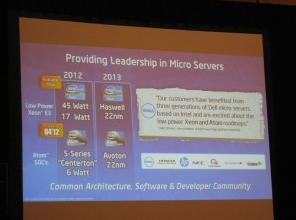
Intel has said it’s on track to launch the next-generation Itanium processor later this year, brushing away any speculation that the processor would reach its end of life in the near future.
The next-generation Itanium chip for Unix and Linux servers, code-named Poulson, will succeed the current Itanium chip code-named Tukwila, which was released in 2009 after many delays. The chip is used in fault-tolerant servers that typically run high-end applications.
“We’re on track for the launch of Poulson later this year,” said Diane Bryant, vice president and general manager of the Datacenter and Connected Systems Group, during an interview at the Intel Developer Forum being held in San Francisco.
Intel is also developing new server chips for workloads such as cloud and high-performance computing. The company has started shipping test units of its Xeon E5 and E7 servers based on the Ivy Bridge microarchitecture, and has assigned the new brand Atom S to its low-power Atom server chips. The Xeon and Atom S chips are targeted at servers based on the Windows and Linux operating systems.
“We have the best solution for every workload that emerges from the data center,” Bryant said.
A big event is being planned for the launch of the Itanium chip code-named Poulson later this year, Bryant said. The company will continue to develop Itanium processors and is developing Poulson’s follow-up Kittson.
“It continues to be a rather lucrative market. For those customers than run Unix we want to continue to have a solution,” Bryant said.
Servers with Itanium chips are mainly offered by Hewlett-Packard as part of its high-end Integrity server line. However, there has been speculation that Intel would stop developing Itanium, which the company has denied.
The Itanium processor architecture has been at the centre of a highly publicised lawsuit between Oracle and HP. Oracle said in March 2011 it would stop software development for HP’s Itanium servers, claiming the processor was reaching end of life.
HP sued Oracle in June that year for breach of contract, and a judge ruled in HP’s favour, ordering Oracle to continue porting software to the Itanium platform. The case’s second phase will begin in February next year to determine whether Oracle breached the contact and the damages it may owe.
Microsoft and Red Hat have already dropped Itanium support for Windows Server OS and Linux respectively.
The Itanium processor business continues to be lucrative, Bryant said. It makes up only three percent of server units, but nearly 25 percent of the revenue.
Intel has also started shipping test units of its Xeon E5 and E7 chips based on Ivy Bridge and made using the 22-nanometer manufacturing process, Bryant said during a separate presentation at IDF. Intel continues to load Itanium-type RAS (reliability serviceability and availability) features in Xeon.
The new Ivy Bridge server chips bring tremendous gains in performance at lower power consumption due to the latest 22-nm process. Current E5 and E7 chips are made using the 32-nm process.
The new Xeon E5 and E7 chips also have a new virtualization feature called APICv, Bryant said. The APICv feature is baked into the hardware and reduces the number of steps involved in deploying and clearing virtual machines.
Intel also said that the new low-power Atom S chip code-named Centerton was due for release in the coming months. HP and Quanta QCT have said they will release servers based on Centerton in the future.
The new server chips will be available next year. Intel usually releases new server chips on a yearly basis toward the end of the first quarter or the second quarter of each quarter. The previous-generation E5 and E7 chips based on the Sandy Bridge microarchitecture were released in March this year.
Companies are trying to harness computing power available in data centres in the most energy efficient way. There is a growing interest in low-power processors like ARM and Atom S, especially from Web-serving companies like Facebook and Google.
The new Atom S chip will have 64-bit and virtualisation features, which is key for cloud deployments. ARM’s 32-bit processors go into most smartphones and tablets, and the processor design company earlier this week said prototype servers based on its first 64-bit architecture will be released as early as late this year, or by the middle of next year.
The second chip in the Atom S lineup will be Avoton, which will be released next year and be made using the 22-nm process. The chip will have integrated fabric to virtualise storage and networking. Bryant did not provide a specific ship date for Avoton chips.





